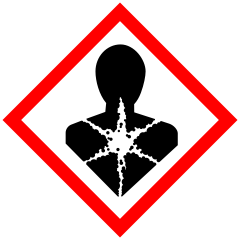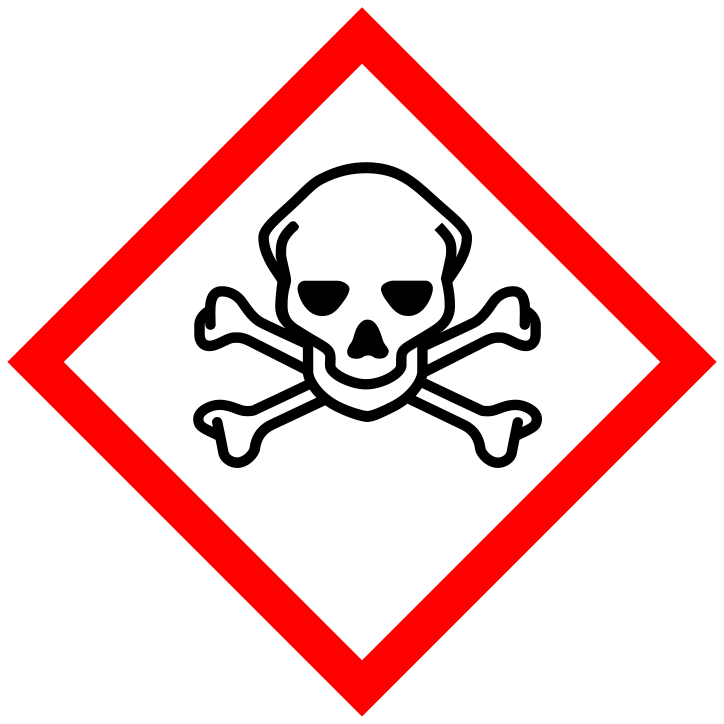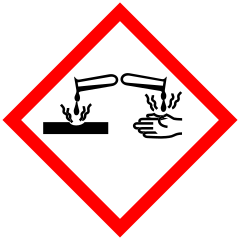Contents
hide
SECTION 1 — PRODUCT AND COMPANY IDENTIFICATION
Product: Formaldehyde Solution
Signal Word: DANGER



SECTION 2 HAZARDS IDENTIFICATION
- Flammable Liquid: Avoid heat, sparks, open flames, and hot surfaces. No smoking.
- Acute Toxicity: Toxic if swallowed, in contact with skin, or if inhaled. Avoid eating, drinking, or smoking when using this product.
- Skin Corrosion: Causes severe skin burns and eye damage.
- Germ Cell Mutagenicity: Suspected of causing genetic defects.
- Carcinogenicity: May cause cancer. Follow special instructions before use.
- Reproductive Toxicity: May damage fertility or the unborn child.
- Specific Target Organ Toxicity: Causes damage to organs.
SECTION 3 — COMPOSITION/INFORMATION ON INGREDIENTS
| Component Name | CAS Number | Formula | Concentration |
|---|---|---|---|
| Formaldehyde | 50-00-0 | HCHO | 37% |
| Methyl alcohol | 67-56-1 | CH3OH | 10-12% |
| Water | 7732-18-5 | H2O | 51-53% |
Synonyms: Formalin, Methanal
SECTION 4 — FIRST AID MEASURES
- If exposed or concerned: Call a POISON CENTER or physician.
- If inhaled: Move to fresh air and keep comfortable for breathing.
- If in eyes: Rinse with water for several minutes. Remove contact lenses if present and easy to do so.
- If on skin or hair: Remove contaminated clothing and rinse skin with water. Wash clothing before reuse. If skin irritation or rash occurs, get medical advice.
- If swallowed: Rinse mouth. Do NOT induce vomiting. Call a POISON CENTER or physician immediately.
SECTION 5 — FIRE FIGHTING MEASURES
- Combustible Liquid: Class IIIA.
- Flash Point: 85°C
- Flammable Limits: Lower: 7%, Upper: 73%
- Autoignition Temperature: 300°C
- In case of fire: Use a tri-class dry chemical fire extinguisher.
SECTION 6 — ACCIDENTAL RELEASE MEASURES
- Remove all ignition sources & ventilate the area.
- Contain the spill with sand or other inert absorbent material & place it in a sealed container.
SECTION 7 — HANDLING AND STORAGE
- Storage Pattern: with hydrocarbons, oils, esters, and aldehydes.
- Precautions: Keep the container tightly closed & cool. Do not breathe mist, vapors, or spray. Use in a well-ventilated area. Keep away from flames & hot surfaces.
SECTION 8 — EXPOSURE CONTROLS, PERSONAL PROTECTION
- Protective Gear: Wear gloves, protective clothing, and eye protection. Wash hands thoroughly after handling. Contaminated work clothing should stay at the workplace.
- Exposure Guidelines: TLV-C 0.3 ppm (ACGIH); PEL 0.75 ppm (OSHA).
- Odor Threshold: 0.05 – 1 ppm.
SECTION 9 — PHYSICAL AND CHEMICAL PROPERTIES
- Appearance: Colorless liquid with a characteristic pungent odor.
- Composition: 37% formaldehyde gas in water, with methanol as a stabilizer.
- Solubility: Water & Alcohol
- Boiling Point: 101°C
- Flash Point: 85°C
- Specific Gravity: 1.08
SECTION 10 — STABILITY AND REACTIVITY
- Avoid: Strong acids, strong bases, and strong oxidizers.
- Shelf Life: Fair (polymerizes slowly to polyformaldehyde).
- Hazardous Decomposition Products: Toxic gases/fumes during burning or thermal decomposition. Combustion may form carbon monoxide & formic acid.
SECTION 11 — TOXICOLOGICAL INFORMATION
- Exposure Route: Eyes, skin absorption, ingestion, inhalation.
- Acute Effects: Severe eye irritant, sensitizer.
- Chronic Effects: Pulmonary edema, carcinogen, mutagen.
- Target Organs: Eyes, kidneys. Effects may be delayed.
- Toxicity Data: ORL-RAT LD50: 100 mg/kg, IHL-RAT LC50: 203 mg/m³, SKN-RBT LD50: 0.27 mL/kg
SECTION 12 — ECOLOGICAL INFORMATION
- Environmental Impact:
Formaldehyde is harmful to the environment, particularly aquatic life. Even at low concentrations, it is toxic to fish and other marine organisms. - Persistence and degradability:
Formaldehyde is readily biodegradable in water and soil. It breaks down through microbial action in the environment, typically within a few days. - Bioaccumulative Potential:
Formaldehyde does not significantly accumulate in living organisms. - Mobility in Soil:
Formaldehyde has high mobility in soil and can contaminate groundwater. It dissolves in water & can spread easily in aquatic environments. - Other Adverse Effects:
Formaldehyde can contribute to the formation of ground-level ozone, a smog component that has various harmful effects on human health and the environment. - Precautions:
Avoid releasing formaldehyde into the environment. Follow the proper disposal methods to prevent environmental contamination.
SECTION 13 — DISPOSAL CONSIDERATIONS
- How to Dispose:
- Follow local, state, and federal rules.
- Don’t throw it in the trash or pour it down the drain.
Recommended Steps:
- Neutralize the solution with a proper agent & place it in a chemical waste container.
- Use a licensed waste disposal service to handle & get rid of it.
Safety Tips:
- Wear gloves, goggles, and a lab coat when dealing with waste.
- Keep containers tightly closed & properly labelled to prevent leaks.
- Avoid spilling into drains, water, or soil. Use secondary containers if needed.
Empty Containers:
- Do not reuse.
- Rinse thoroughly with water before disposal.
- Follow local & federal rules for disposing of rinsed containers.
SECTION 14 — TRANSPORT INFORMATION
- UN2209 — FORMALDEHYDE SOLUTIONS — HAZARD CLASS 8 — PG III
SECTION 15 — REGULATORY INFORMATION
- Listed: TSCA, EINECS (200-001-8), RCRA code U122.
SECTION 16 — OTHER INFORMATION
This Safety Data Sheet (SDS) is for guidance and based on reliable information. Laboratory cognizance does not guarantee the accuracy or completeness of the data & shall not be liable for any damages. The data should be used for consideration, investigation, and verification, and must comply with local, state, or federal laws & regulations. Handling, storage, use, and disposal are beyond Laboratory Cognizance’s control. No responsibility or liability is assumed for loss, damage, or expense connected with this product.
